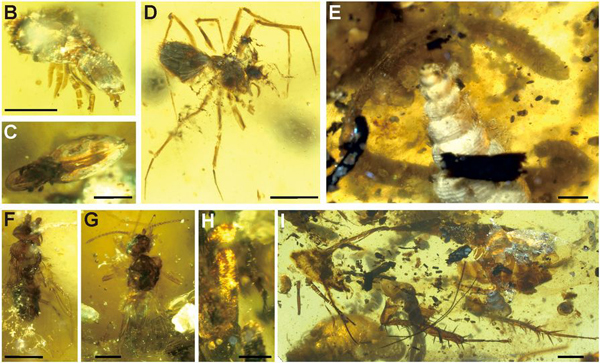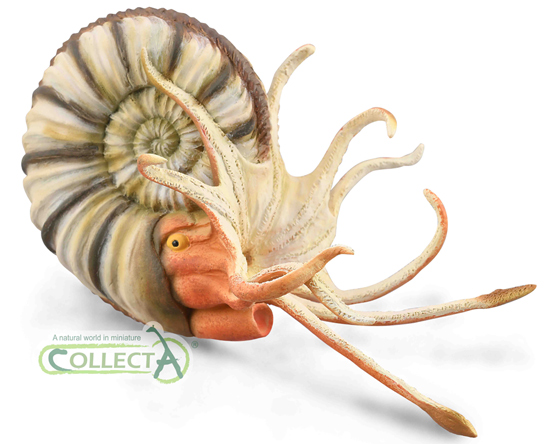Ammonite Shell Preserved in Amber from Myanmar
Ammonite Trapped in Nodule Helps to Date Myanmar Amber Fossils
This month has seen the publication of yet another remarkable paper detailing fossil discoveries found within amber nodules from northern Myanmar. Writing an open article in the PNAS (Proceedings of the National Academy of Sciences of the United States of America), the researchers document a variety of terrestrial and marine invertebrates consisting of molluscs, insects, spiders and mites that have been preserved trapped in a piece of fossilised tree resin that dates from around 99 million years ago.
The organic remains consist of a mixed assemblage of intertidal and terrestrial floor organisms and suggests that the Cretaceous Myanmar forest was adjacent to a shifting and dynamic coastal environment. The identification of the ammonite at the genus level has permitted the researchers to provide supporting evidence as to the age of the amber.
The ammonite shell is a juvenile Puzosia and its discovery adds weight to those academics proposing the dating of the amber to Late Albian–Early Cenomanian.
The Amber Nodule (Myanmar) with the Preserved Invertebrate Remains
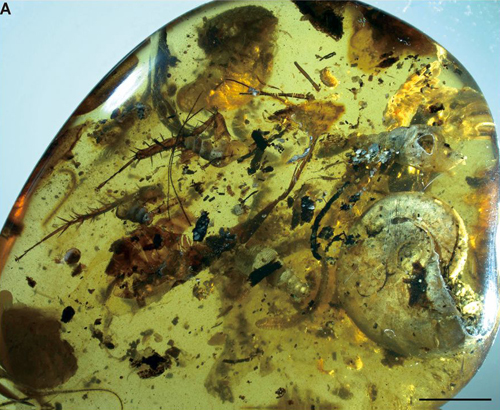
Picture credit: PNAS
This is a rare example of a marine organisms associated with tree resin and also represents a rare instance of the dating of fossil tree resin using the remains of organisms trapped within an amber nodule.
X-ray-microcomputed Tomography (CT) Scans
The amber from northern Myanmar has provided palaeontologists with some fascinating fossils to study, including feathers, baby birds and even the partial tail of a feathered dinosaur. The amber nodule in this study (BA18100), was obtained from an amber mine close to Noije Bum Village, Tanaing Town and it weighs a fraction over six grams. Measuring 33 mm long, 9.5 mm wide and 29 mm high, it contains a diverse assemblage of at least forty individuals. X-ray-microcomputed tomography (CT) scans was employed to help identify the fossil material.
Specimens from the Amber Nodule (BA18100)
Picture credit: PNAS
The Ammonite Shell Remains
The ammonite appears to be a juvenile and from a review of the septa (the complex boundary lines outlining the chambers), it has been identified as a member of the Puzosia genus. This type of ammonite is known from the Cretaceous of the western Tethys Ocean, these fossils help to support the fossil record for this genus from the eastern Tethys region.
The ammonite has a diameter of around 12 mm and it appears to retain its original aragonite shell, that is the shell has not undergone any mineral replacement as expected during fossilisation. The shell is almost complete, only the final body chamber is damaged as part of the umbilical wall extends beyond the fragmentary last part of the shell.
Views of the Ammonite Preserved within the Amber
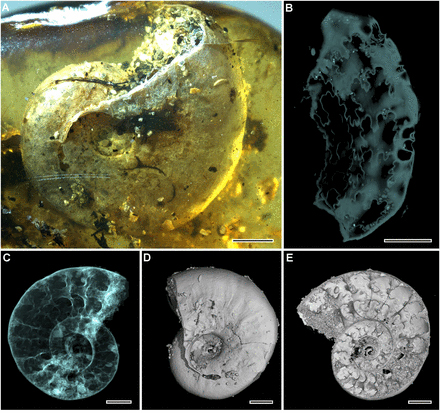
Picture credit: PNAS
Marine Snail Shells (Gastropods)
The amber also contains the remains of marine snails. Two of the gastropods have been identified as the genus Mathilda. This type of marine snail is known from the western Tethys Ocean, but this is the first time that this marine snail genus has been recorded from the eastern Tethys. The incomplete preservation and lack of soft body of the ammonite and marine gastropods suggest that they were dead and underwent abrasion on the seashore before entombment within the tree resin.
Views of the Marine Snail Shells (Gastropods)
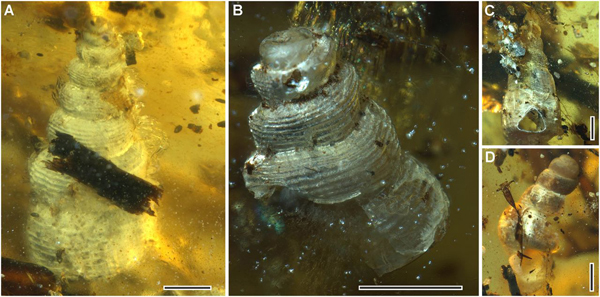
Picture credit: PNAS
Isopods Along with an Ammonite Shell
At least four isopods are also present. Isopods are crustaceans and these creatures are known from terrestrial, brackish, freshwater as well as marine environments. Unfortunately, the researchers were not able to identify the remains to the extent whereby it could be determined whether the preserved individuals came from the land or were aquatic.
Isopods Preserved within Amber
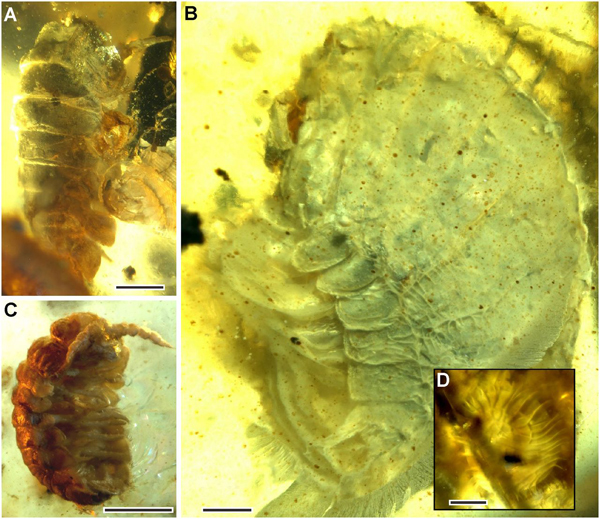
Picture credit: PNAS
How Did the Marine Assemblage End Up in the Tree Resin?
The scientists conclude that the tree resin fell onto the beach from coastal trees, for example araucarian conifers could have been growing close to the shore and the resin originated from one of these trees. As it slid down the tree trunk it picked up terrestrial creatures and under gravity is moved across the sand picking up the shells on the beach. It is remarkable that the tree resin survived the high-energy shore environment before being preserved as amber.
The authors, which include scientists from the Chinese Academy of Sciences suggest that resin ending up on the beach due to the proximity of the conifers could have been a relatively common event. However, since this is the first time that an ammonite shell has been discovered entombed, the odds of fossilisation occurring and the material surviving long enough to turn into amber marks an exceptionally rare occurrence.
A Model of an Ammonite
The image (above) shows a model of an ammonite from the CollectA Age of Dinosaurs range.
To view this range of prehistoric animal figures: CollectA Age of Dinosaurs/Prehistoric Life.
The dating of amber can be extremely difficult as these pieces can be reworked and redeposited. The finding of an ammonite within a nodule, provides biostratigraphical dating support attesting to the 99-100 million-year-old estimate for these types of ancient tree resin from northern Myanmar.
The scientific paper: “An ammonite trapped in Burmese amber” by Tingting Yu, Richard Kelly, Lin Mu, Andrew Ross, Jim Kennedy, Pierre Broly, Fangyuan Xia, Haichun Zhang, Bo Wang, and David Dilcher published in the “Proceedings of the National Academy of Sciences of the United States of America.
Visit the award-winning Everything Dinosaur website: Everything Dinosaur.


